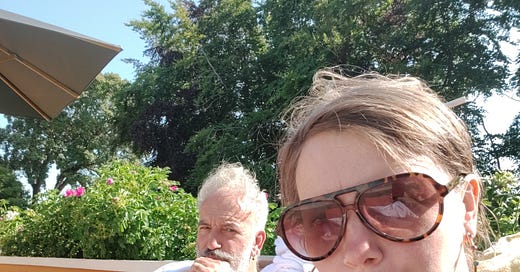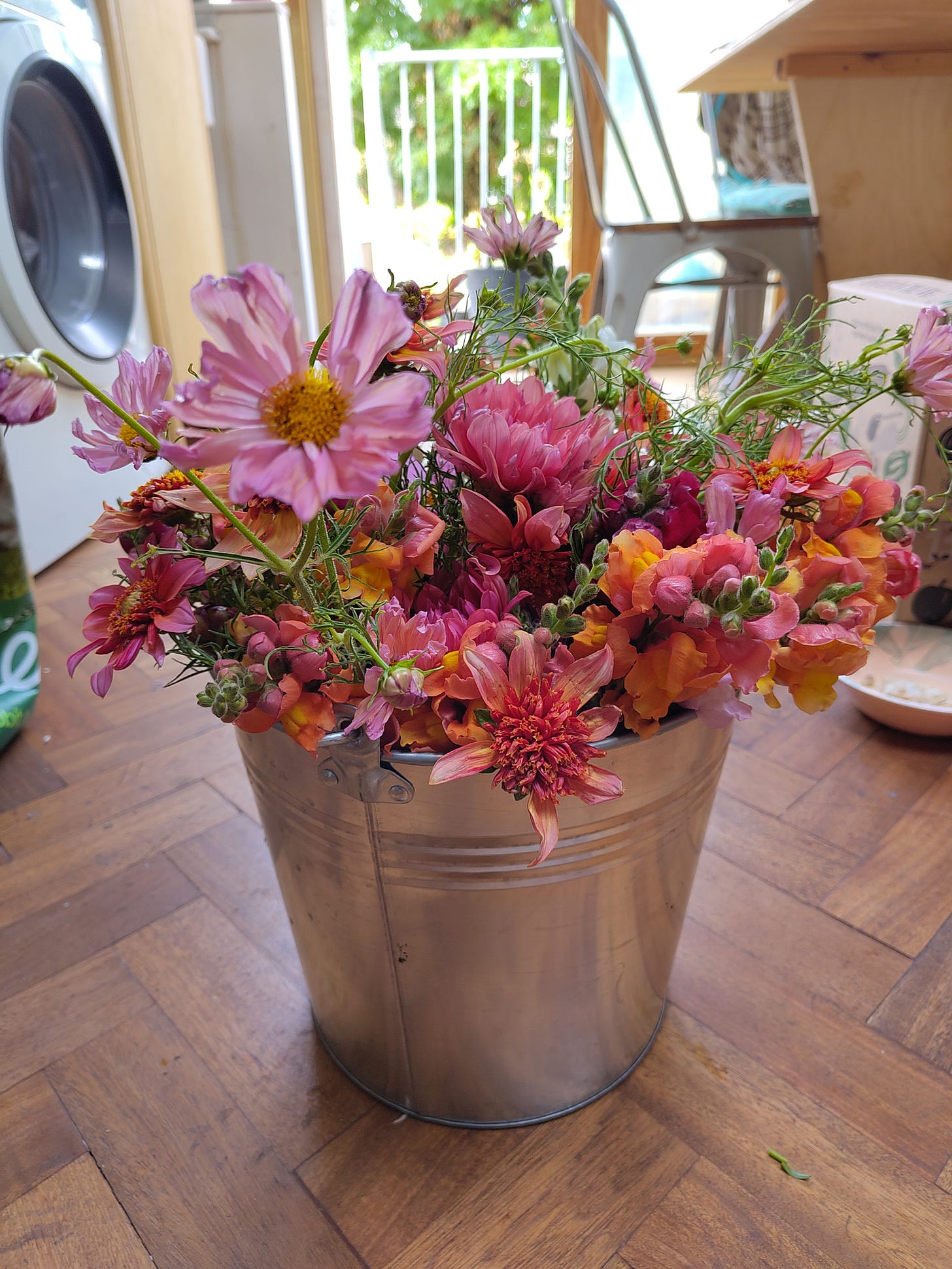It's been a while since Joel and I hashed out the rough structure of this blog series, so I can't exactly remember why embeddedness in a region felt like one of our top 12 priorities. However, writing this right now, on our way to a spa to celebrate my 40th birthday, I feel the resonance of the universe, in bringing this thought process back to my mind at this moment.
Joel and I regularly discuss alternative ways of organising society, both online and in person. At a recent lecture that I gave for CSM MA Arch (Architecture post grad) on the fashion commons, one student expressed the argument against building the Commons, that I’ve heard most often. It goes something like; “Sure, you could build this amazing alternative structure for society, but what's to stop someone just coming and taking it off you?”
Looking back over the past 200 years of colonialism, and all the beautiful cultures that had their stuff ‘just taken’ through white greed and violence (yes, I think about the Roman Empire on a regular basis, but not in a good way) it's easy to see how this fear has embedded itself in our collective psyche.
There are lots of responses to this question. Some of them are about how our freedoms and ease within capitalism (for those of us with privilege) are constantly being squeezed, eroded and taken away, so what's the difference?
Some are about how armies were raised while there was a commons system in place in the past i.e. violent defence is not incompatible with a commons system.
But for me, the most positive response is to think about how we can make our neighbours love us so much that they will join us and defend us against having our stuff taken away, and to this end I suggest the age-old relationship building strategy of trade.
Joel and I both have a fair bit of experience of selling our skills on the market. As a stone carver Joel has interacted with affluent customers, who are willing to pay to protect their investments. As an entrepreneur I always struggled. I saw the bespoke underwear I was making as an object of Care; fine tuned to meet the needs of the wearer, whilst always striving to be responsible to the needs of a living planet. Whenever I made underwear as a gift, I loved it. I loved the creativity, the delight of the receiver, the forging of a relationship. Whenever I made underwear for money, I would struggle. For the most part I just couldn’t meet the expectations of customers who had only ever known mass-production-using-a-vulnerable-workforce consumerism. The transaction, which was inevitably more than what they were used to paying, still couldn’t account for all my costs, not to mention all the wrongs of society that we were righting (like how bras never fit well, or come in a colour that you don’t like).
How can we make trade closer to the gift exchange than the transaction exchange? (obviously I’m leaning into Graeber’s work quite a lot here). Where we’re at theoretically, is-
-Exchanges to meet your basic needs, should be within a tight network, a commons. A network where kinship ties, and mutual attachment to a piece of land, and shared decision making are also present. I.e When meeting basic needs, each person should have an idea of what the other person has gone through to, for instance, grow that wheat without fertiliser or knit that angora vest. Each person should have experienced each others work, should be able to empathise with its challenges etc.
-Wider trade should, as much as possible, be outside of the constraints of ‘needing to make a living’, it should be generous, evangelical, a tantalising taste of the new model that’s emerging. Perhaps it should have tiered pricing, to undermine traditional hierarchies. It should be relaxed and low stakes.
Which leads me nicely back to Spas :-). What’s more generous, more tantalising, more evangelical than a nature based spa?? Joel and I fully intend that there should be a natural spa on the farm ANYWAY for community use; Saunas on the hill, natural swimming ponds, massages, sunken clay and stone lined hot tubs in the woods. A swimming pool that goes from inside the orangery greenhouse to outside into a lush flower garden. Maybe even some herbal bath tubs a la spirited away. Probably, a yoga studio with big french doors that looks out onto a courtyard with a natural swimming pond in it. These things serve the wellbeing of the community. They allow everyone to decompress at the end of a hard day's scything. They are a testament to the mutual thriving that we hope the Care.Home.Farm will embody.
At the weekend we went to a gorgeous spa on an estate with its own no dig market garden. It was beautiful, buuuut, they had surrounded the outdoor pool with astro turf, and it was heated, which in the 30 degree solstice sun wasn’t actually that pleasant. The next day we camped on our friend's land, and he generously allowed us to use his own natural swimming pool that is cleaned by a reed bed. Although we enjoyed both experiences, the contrast was compelling. It was obvious to see the compromises that a capitalist system was forcing on the spa hotel, whereas the gift economy natural pool was absolutely idyllic.
The Spa is a perfect example of how community thriving can create opportunities for embeddedness in the a regional community. We build it anyway, for our own wellbeing, but once we have it, it's not a massive amount of extra effort to make it available to other people. Well being is an area where the Care Home Farm can have a genuine gift to give its neighbours. The system is designed to be slower, more relaxed, experimenting with experience to interrogate wellness for the human who is embedded in the more-than-human context. Wellness in work and in leisure. Pools without concrete and chemicals, skincare without detergents and synthetics, nature without plastic. In our world, time and access to space for relaxing and healing the body has become luxury.
At Care Home Farm, these versions of luxury, luxurious because of the human artisanship they require, represent both a financial drawdown opportunity, and a co-benefit of deep gifts of care at the hyperlocal and local level, that can bring pragmatic realism to Common’s projects. I would suggest (without in depth financial mapping, although we’ll get to that) that the Care Home itself, the cultivation of natural fibres and luxury plants and the creation of handmade artisan goods, also offer this same opportunity. It's a model that I’m constantly developing in my roles as a researcher and a practitioner at The Remakery. Simply put, we’ll sell a regenerative angora jumper to a wealthy person, and we’ll swap one with a member of our CSA. We’ll sell a 5 day spa retreat and basket making course to a wealthy person, and we’ll allow a local scout group to stay on our site and do bushcraft for (as good as*) nothing *charging some money means people turn up to stuff…
We’ll charge those who can afford it for our craft based, organic catering, residential care, but that means we’ll have the facilities to look after our own loved ones to the high standard that will bring us joy.
Vice Versa, there will be growing, making and caring practices going on on the farm anyway, and some of these can produce surplus without too much extra effort that can be traded to produce both money for council tax, for a rainy day, or for investment into new Care.Home.Farms, and to produce social relations with our neighbours.
Businesses on our land that can transform surplus into community love.
A Garden Centre; Not to be crude but Nimby’s love a garden centre. That is exactly the kind of shizzle that they do in fact want in their backyard. If we’re growing trays of seedlings for a market garden, and running an in house tree nursery, and turning our own trowel handles then a garden centre is a no brainer.
Skincare- handmade organic, beeswax and cold pressed walnut/rosehip oil skincare with macerated herbs tailored to your unique profile. Yes please.
Spa- I’ve already talked enough about the spa.
Bespoke Clothing/Shoes- Even a mass produced pair of cashmere knickers start at £150
Weddings- Imagine you can pick your wedding flowers from a regenerative agroforestry system, and order your perry with a custom printed label. All the catering is organic seasonal produce, and there’s a gorgeous half timber barn with an outside courtyard for dancing. It's what weddings should be.
Community Supported Agriculture- From what I’ve gleaned, selling veg within capitalism kind of sucks, but inviting people to take part in the growing process and be more intersufficient themselves is beautiful.
As with all elements of a Commons, it's important that balance is negotiated, to ensure that ‘free riders’ aren’t exploiting systems (natural or societal), in order to hoard personal wealth. This is the well documented- tragedy of the Commons. Thankfully Ostrom (who is still my favourite Nobel Prize Winning Commons thinker) did provide us with useful data led, research on how negotiation, boundaries and accountability can help maintain a multigenerational balance that can protect natural and cultural resources.
As Graeber puts it in his lecture on Care and Freedom. We need to reimagine production and consumption. We need to produce ‘Care’ not money, and this is really the central ethos of the Care.Home.Farm project. By building outside of the debt and rent based economy, we are able to share this Care outside of the farm community, whilst ideally drawing down resources and returning them from enclosures to Commons.
The next Care.Home.Farm zoom meeting will be on the 16th July at 7pm, to come along and discuss these ideas with us email care.home.farm@gmail.com for the zoom link.





